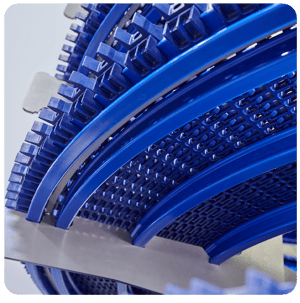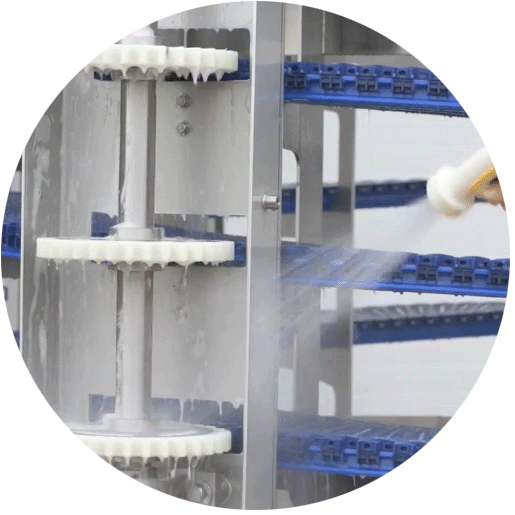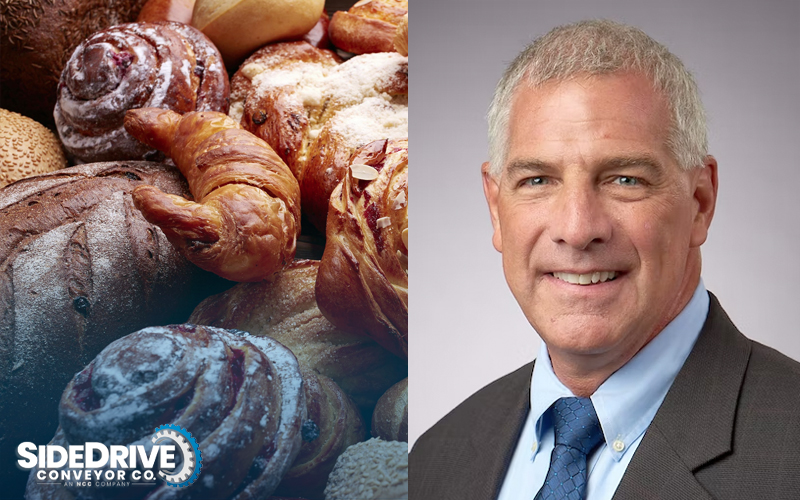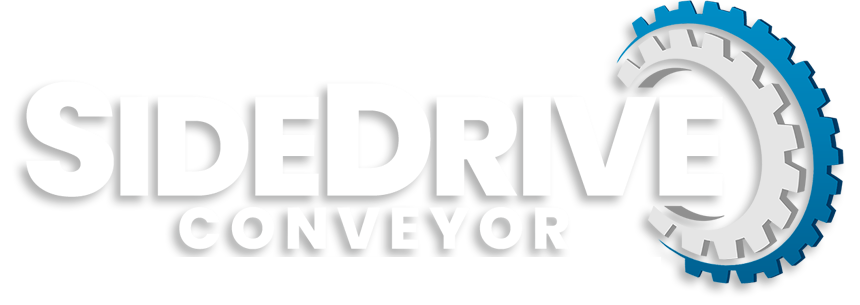Joanie Spencer, editor-in-chief of Commercial Baking, talks with Tony Maniscalco, business unit leader at SideDrive Conveyor Co. In this TechTalk, they discuss the importance of sanitary design in product conveyor systems.
Sanitary Conveyor Designs for Commercial Bakers
Joanie: Sanitary design has been a huge priority for commercial bakers over the last five or ten years in this era of physma. How have you seen it impact your customers' needs for hygienic conveyor systems?
Tony: Sure, that's a good question. The plants must have a food safety plan for hazard analysis and preventive controls. Currently the FSMA focuses on the prevention of foodborne illness rather than being reactive to the issues that come up. The impact in the baking industry is related to the rules of the process control that would target food allergens to eliminate cross contact and also sanitation controls. With that said, the prevention aspect of the FSMA can be the guidance to the decision of the conveying system to properly transfer the product to (1) avoid catch points that create damage or spillage of the product (2) to ensure the sanitation process is effective to remove allergens and contaminates. These rules established the conditions to minimize and prevent hazardous of the environmental pathogens.
Wear Strips Pros and Cons
 Joanie: Yes, that is so important and when I think about sanitary design in conveyors systems, the first thing that comes to mind for me is the wear strips. Can you talk about what some of the benefits are for SideDrive’s wear strips?
Joanie: Yes, that is so important and when I think about sanitary design in conveyors systems, the first thing that comes to mind for me is the wear strips. Can you talk about what some of the benefits are for SideDrive’s wear strips?
Tony: Sure, the benefits are that they are made of a USDA compliant plastic material. We use compliant material for the wear strip. It’s a smooth one piece excursion that supports the intralox 2700 series belt. It’s the only belt we use for the system. The connection to the frame is with a special lock mechanism, this unique design eliminates harborage points compared to traditional snap-on wear strips. Specifically the system was designed for heavy high pressure washdown environments that can withstand exposure to typical chemicals used during the sanitation process.
Sanitary Frame and Sprocket Design
Joanie: Okay, so sometimes I think bakers might only think of the belting when they are considering hygienic conveyor design because it's the touch point for the product. Why are sanitary frame and sprocket design important when you are thinking about the conveyor system too?
%20for%20Sanitary%20Spiral%20Conveyors/Rail%20CTA%20-%20How%20to%20Evaluate%20Overall%20Equipment%20Effectiveness%20(OEE)%20for%20Sanitary%20Spiral%20Conveyors.png?width=300&height=331&name=Rail%20CTA%20-%20How%20to%20Evaluate%20Overall%20Equipment%20Effectiveness%20(OEE)%20for%20Sanitary%20Spiral%20Conveyors.png) Tony: the frame structure should be designed to allow accessibility for maintenance and sanitation. The design of the structure should in effect eliminate harborage points that are difficult to clean during the sanitation process. Ultimately that improves labor time, saves on water and cleaning agents. These improve availability of the machine as it relates to the Overall Equipment Effectiveness. SideDrive Conveyor has a drumless design, open stainless steel canleaver frame with sloped surfaces, rounded edges and continuous wells, welded standoffs that have least horizontal contact points to eliminate harborage points. The other part of this is that sprockets are designed again for easy sanitation using USDA elinatron compliant material, it has stainless steel brackets designed to maximize cleanability. It’s still be displaced and disassembled without disassembling the shaft.
Tony: the frame structure should be designed to allow accessibility for maintenance and sanitation. The design of the structure should in effect eliminate harborage points that are difficult to clean during the sanitation process. Ultimately that improves labor time, saves on water and cleaning agents. These improve availability of the machine as it relates to the Overall Equipment Effectiveness. SideDrive Conveyor has a drumless design, open stainless steel canleaver frame with sloped surfaces, rounded edges and continuous wells, welded standoffs that have least horizontal contact points to eliminate harborage points. The other part of this is that sprockets are designed again for easy sanitation using USDA elinatron compliant material, it has stainless steel brackets designed to maximize cleanability. It’s still be displaced and disassembled without disassembling the shaft.
Commercial Bakers Taking Cues from the Meat & Poultry Industry
Joanie: So you mentioned USDA a couple of times, and that reminds me that the sanitary design in the baking industry has taken a lot of cues from the meat industry. Can you tell me what some of the latest developments are with USDA approved conveyance equipment and how that's impacting SideDrive’s design?
 Tony: I think we have really addressed it but it's all about the effectiveness of the sanitation. The open frame structure, cleanability, eliminating harborage points. It’s really essential. Toolless removal of certain components as much as possible. Those features are advancements and they will continue to be the focus as it relates to sanitation and accessibility of the equipment.
Tony: I think we have really addressed it but it's all about the effectiveness of the sanitation. The open frame structure, cleanability, eliminating harborage points. It’s really essential. Toolless removal of certain components as much as possible. Those features are advancements and they will continue to be the focus as it relates to sanitation and accessibility of the equipment.
Versatility, flexibility in the Sanitation process
Joanie: Yeah, food safety is one issue that we are not going backwards. It's not going away and it's not going to be less important. It’s only going to continue to become more and more important don’t you think?
Tony: Yeah, absolutely. One of the things we continue to hear about is really about the versatility, the flexibility and the sanitation processes. They continue to look for improvements but what's next and what's best, what is coming around the corner to really look at how we are going to protect the environment and the conditions. So everything is about food safety and anything that comes in-contact with it.
Joanie: Tony, what is the best way for a baker to get in touch and learn about these technologies and how they can incorporate them into their operation?
Tony: Well obviously they can go to our website, www.sidedriveconveyor.com where we have a series of downloads, videos and podcasts. They can simply call us at 267-203-8355. We are also on social media like Linkedin, Youtube, Facebook, Twitter and we have upcoming trade shows as wel, you can visit our site in the booth and go from there.




 Joanie: Yes, that is so important and when I think about sanitary design in conveyors systems, the first thing that comes to mind for me is the wear strips. Can you talk about what some of the benefits are for SideDrive’s wear strips?
Joanie: Yes, that is so important and when I think about sanitary design in conveyors systems, the first thing that comes to mind for me is the wear strips. Can you talk about what some of the benefits are for SideDrive’s wear strips? %20for%20Sanitary%20Spiral%20Conveyors/Rail%20CTA%20-%20How%20to%20Evaluate%20Overall%20Equipment%20Effectiveness%20(OEE)%20for%20Sanitary%20Spiral%20Conveyors.png?width=300&height=331&name=Rail%20CTA%20-%20How%20to%20Evaluate%20Overall%20Equipment%20Effectiveness%20(OEE)%20for%20Sanitary%20Spiral%20Conveyors.png)
 Tony: I think we have really addressed it but it's all about the effectiveness of the sanitation. The open frame structure, cleanability, eliminating harborage points. It’s really essential. Toolless removal of certain components as much as possible. Those features are advancements and they will continue to be the focus as it relates to sanitation and accessibility of the equipment.
Tony: I think we have really addressed it but it's all about the effectiveness of the sanitation. The open frame structure, cleanability, eliminating harborage points. It’s really essential. Toolless removal of certain components as much as possible. Those features are advancements and they will continue to be the focus as it relates to sanitation and accessibility of the equipment. 